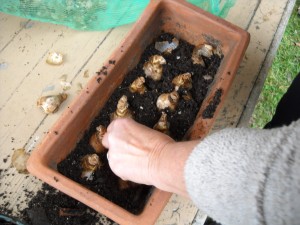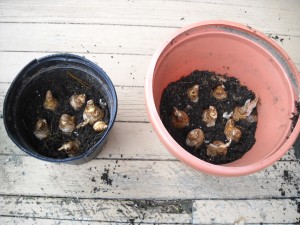Forcing Bulbs for Spring
Winters can be hard on many gardeners: short dark days, icy roads and little to do in the garden. Yes, I like to snow shoe and cross country ski, but it doesn’t replace gardening. I water my houseplants (and occasionally talk to them), but they are weak substitutes for the real thing. By the time mud season comes in March, I want blooming flowers to brighten my life.
I get early blossoms in two ways: First, I have early bulb plants outdoors, including hundreds of snowdrops that bloom in March. And second, I force bulbs to bloom early indoors. Now is the time to plant bulbs so that they will bloom when we need them the most – a month or two before they bloom outdoors.
In order to prepare bulbs for early blooming indoors, you will need a place to store them that is cold, but not as cold as the outdoors. Despite global warming, I still see minus 20 every winter, even if for only a few days. Bulbs planted in the ground have some protection against the cold, but if you were to plant bulbs in pots and leave them outside, the extreme temperatures would kill most. Bulbs left in a cool basement or garage will do just fine.
Ideally temperatures for bulbs used for forcing will be between 33 and 50, though a few days of below freezing temperatures is not be a problem (my basement often goes a below freezing). Left in a warm location, the bulbs will grow green tops – but not blossoms.
Bulbs can be planted for forcing in pots or window boxes. Good drainage is important to avoid rotting the bulbs, so don’t plant them in ordinary garden soil. I think an ideal mix is one that has half compost and half potting mix. I want the mix to be lightly moist at planting time, but not soggy. Once a month I check the pots to make sure the soil is not bone dry; if it is, I water lightly.
When planting daffodils or tulips outdoors, I plant them 6-8 inches deep but that is not necessary when planting bulbs in pots. Depending on the type of container I use, the pointy tips of my bulbs may be just an inch or two below the soil surface. And I plant them shoulder-to-shoulder, crowding in as many bulbs as possible in the container. After they finish blooming in the spring I will plant the bulbs outside, but for now they have everything they need to bloom inside the house.
Timing is key to success with forced bulbs. Little bulbs like crocus need just 8-10 weeks of dormancy, but daffodils need 12 weeks, and tulips do better with more, up to 16 weeks. Choose bulbs that are marked “Good for Forcing” or that are listed as “early” rather than mid-season or late. If you are selecting bulbs now, make sure that they are still firm, not papery and dried out. And if you see them with long green sprouts, pass them by.
Beware of mice. If you have mice, they will eat your tulips unless you exclude them somehow – with wire mesh screening, for example. Daffodils are lightly poisonous, so mice don’t eat them.
You can maximize blooming by planting two layers of bulbs. I often use those 8-inch pots that perennials come in for forcing. They are not elegant, but can be dressed up with wrapping paper or baskets when displayed on the table. I put in an inch of gravel, an inch or two of soil mix, then daffodils or tulips. I cover them with soil, and then add a second layer of bulbs. The small bulbs like crocus work well for a second layer. Leave a little space at the top of the pot for watering.
When planting two layers of bulbs I used to worry about the big bulbs coming up and pushing the little ones aside like playground bullies. So I carefully placed the little ones above the spaces between daffodils. I even used broom straws to show me where to plant. But one year I just put them in without worrying about crowding and every bulb did fine. Plants know more than we give them credit for, I think.
When you take your plants out of their cold resting spot, most will begin to grow almost immediately. I generally start mine off in a cool location in the house, and once they have fully woken up I put them on a sunny, warm windowsill. A trick for prolonging their blooms (which also works with cut flowers from the florist) is to move the flowers into a cold mudroom or entryway at night. Cool temperatures prolong the life of your flowers.
So go to your local feed-and-grain store, garden center or food coop; get some bulbs and prepare them for forcing. Come March you’ll be ready for spring, and will have some flowers ready to perform their annual dance before their cousins outside do.
Henry Homeyer has a new children’s chapter book that just came out: Wobar and the Quest for the Magic Calumet. Read about it at www.henryhomeyer.com.




